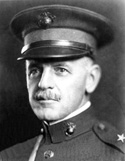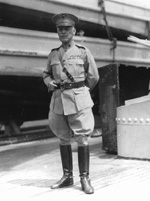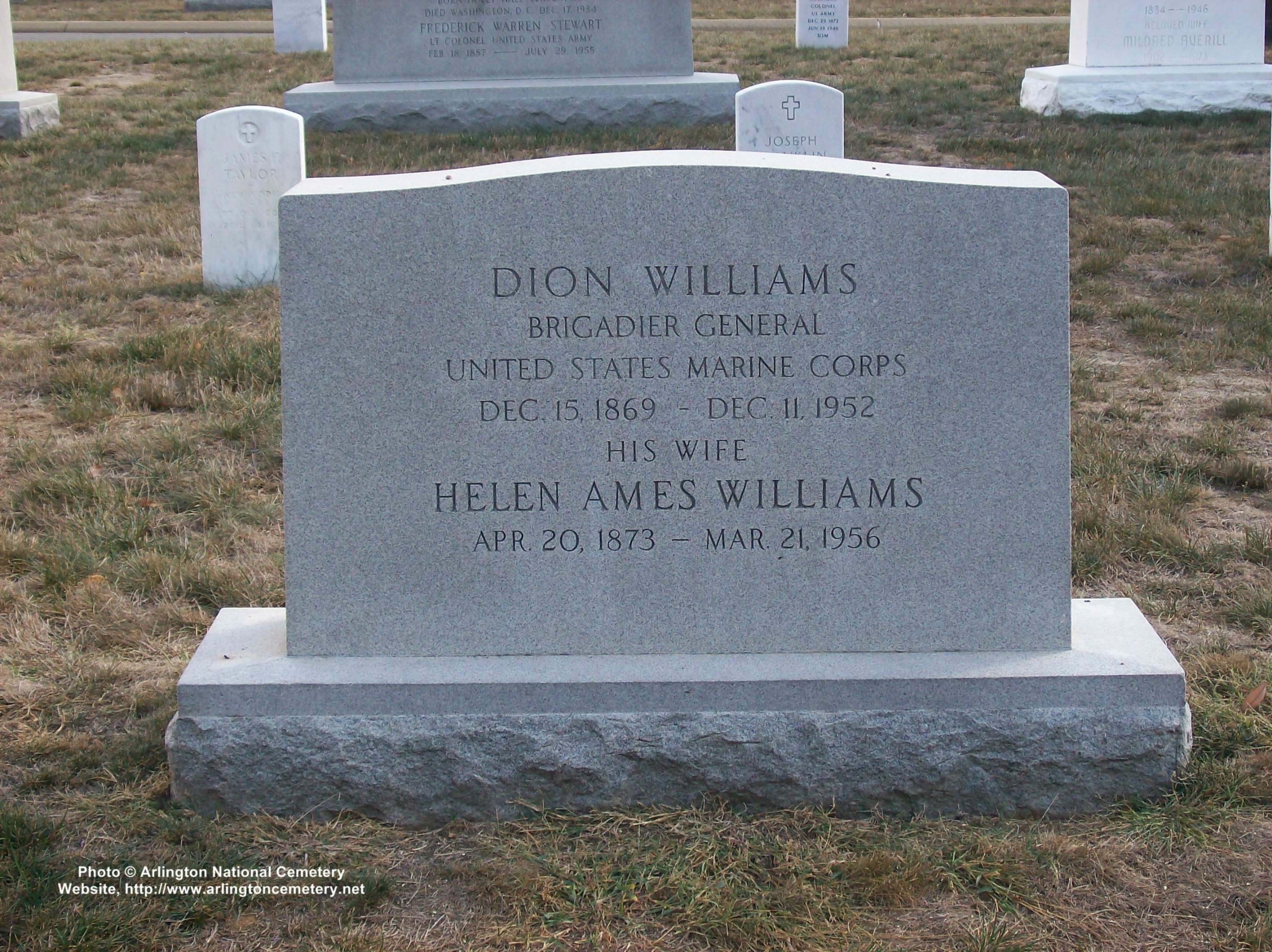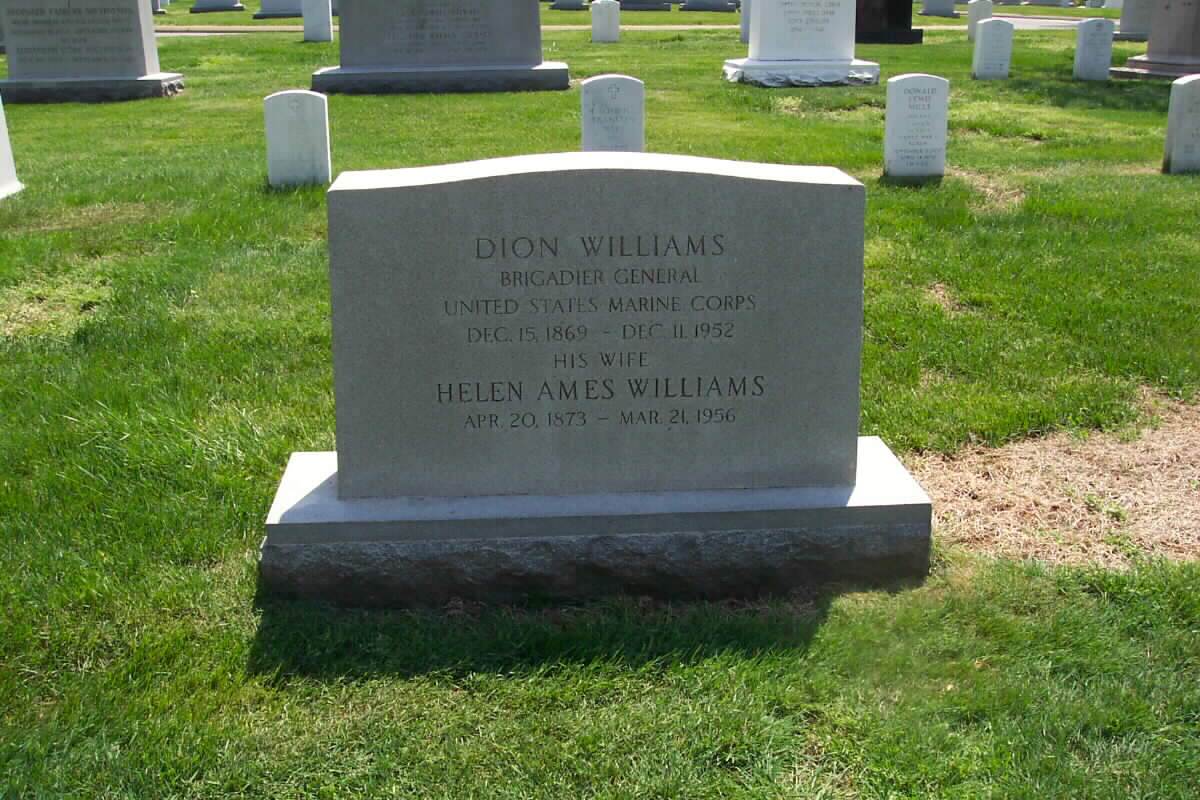Courtesy of The Marine Corps Gazette
Brigadier General Dion Williams, USMC (1869-1952)
by GySgt Leo J. Daugherty III, USMCR

Career
Born 16 December 1869 in Williamsburg, Ohio, Dion Williams received his early education there until entering the Naval Academy as a member of the Class of 1891. After completing the required 2-year cruise, he was commissioned as a Marine second lieutenant in 1893. He attended the School of Application and then served at Marine Barracks in New York and Mare Island. During the war with Spain in 1898, Williams along with a detachment of Marines from the USS Baltimore raised the first American flag over the Spanish naval arsenal at Cavite in the Philippines. Duty at Marine Barracks Boston followed. Called out for a minor revolt in Panama (1902), Williams commanded a company of Marines sent to disarm Colombian troops threatening the Americans. Leaving Panama his company then participated in the first advanced base exercise on Culebra.
In March 1905 Major Williams reported to Naval War College, where he authored what can be considered the first doctrinal study concerning the importance of amphibious reconnaissance in 1906. The study, which he revised in 1917 to take into account the advent of airplanes and submarines, established the guiding principles for conducting amphibious reconnaissance prior to an amphibious assault. The revised edition also placed greater emphasis on conducting reconnaissance prior to the planning and embarkation of an advance base force. Many of the reconnaissance ideas advanced in these studies survived and were eventually incorporated in the Tentative Manual for Landing Operations developed in 1934.
After a tour of duty at the Office of Naval Intelligence, 1909-1913, Williams served in the Peking Legation Guard and then became the Marine Corps’ representative to the General Board of the Navy, 1915-1918. Assigned as the commanding officer, 10th Marines, Williams remained at Quantico preparing that regiment for combat duty in France during World War I (1917-1918). After the armistice, Williams then served as commanding officer, 2d Provisional Brigade, on pacification duty in the Dominican Republic. Returning to the Quantico in 1921, he assumed command of the 4th Marine Brigade as part of the the East Coast Expeditionary Force participating in the ongoing advanced base exercises held by the Navy’s North Atlantic Fleet. He commanded this force during the 1924 Winter Maneuvers that witnessed the first use of an experimental amphibious tank mounting a 75mm gun, as well as the “beetle boats” uses as amphibious transports. In a March 1924 Marine Corps Gazette article, Williams recounted the problems and successes of this first major exercise since the end of World War I. Williams likewise participated in the joint Army-Navy landing exercises off Oahu, Hawaii, in January 1925. He incorporated many of the lessons learned in another Gazette article in June 1926, outlining what he considered the proper organization for a fleet landing force.
From 1906 onward, Williams was a prolific writer and an innovative thinker contributing to the evolution of the Corps and the refinement of its missions and doctrine. After his tour of duty with the 4th Brigade ended, Williams became assistant to the Major General Commandant (1928), whereupon he became editor of the Gazette. He remained on duty at Headquarters Marine Corps until his retirement in 1934. Despite his retirement, Williams remained active, authoring several articles on officer professional education and the curriculum at Marine Corps Schools, and participating in Marine Corps affairs. He died on 11 December 1952 at the age of 83 and was buried in Arlington National Cemetery.
GySgt Daugherty wishes to thank Mrs. Amy Martin of the Williamsburg Public Library and the staff of the Marine Corps Historical Center for their help in compiling information on General Williams.
DION WILLIAMS, 82, A MARINE GENERAL
Retired Officer Who Raised U.S. Flag in Manila Bay
During Dewey Victory is Dead
WASHINGTON, December 11, 1952 – Brigadier General Dion Williams, U.S.M.C., retired, who raised the American flag at Manila Bay in 1898 during the Spanish-American War, died today after an illness of several months, at the Naval Medical Center at nearby Bethesda, Maryland. He would have been 83 years old next Monday.
General Williams’ flag-raising exploit followed his taking ashore a company of Marines from the USS Baltimore as Admiral George Dewey defeated the Spanish naval forces in the Philippines. He also served early in the century in Panama and Cuba and from 1913 to 1915 headed the Marine Guard at the Peking Legation. In 1925 he was Assistant to the Commandant of the Marine Corps. He retired January 1, 1934.
General Williams is survived by his widow, Helen. The Williamses made their home in the District of Columbia.
General Williams was in command of the Marine Occupation Force in Nicaragua from April 1929 through 1930. A graduate of the Naval Academy, he was a First Lieutenant when he raised the flag at Manila in 1898. In January 1942, he participated in a ceremony at Annapolis, where the same flag is now enshrined. It was just after evacuation of the Cavite Naval Base to the Japanese.
“We put it up once. We’ll do it again,” he said.


Michael Robert Patterson was born in Arlington and is the son of a former officer of the US Army. So it was no wonder that sooner or later his interests drew him to American history and especially to American military history. Many of his articles can be found on renowned portals like the New York Times, Washingtonpost or Wikipedia.
Reviewed by: Michael Howard

